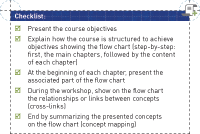TD Magazine Article
Member Benefit
Presenting Course Outlines in a Flow Chart Format
When a trainer introduces a course or workshop outline, he provides a snapshot of what will be covered, including the learning goals, timeline, activities, assignments, and other pertinent information to the participants. According to Pat McLagan, trainers can help learners develop an early and appr...
EA
By
Fri Feb 19 2010
Loading...

You've Reached ATD Member-only Content
Become an ATD member to continue
Already a member?Sign In
